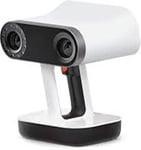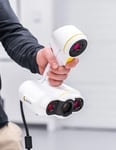Over the last few years, 3D scanning technology has become more accessible and affordable, resulting in an influx of new scanning hardware on the market. This has made it much easier for both consumers and professionals to capture real-world objects and recreate them in the digital format.
One of the pioneers in professional-grade handheld 3D scanners is Artec 3D, a company with a respected line of products and a growing presence throughout the global market.
Following in the footsteps of the flagship Artec Eva, which was released back in 2012, the Luxembourg-based manufacturer has come out with one of its most innovative products yet, the Artec Leo.
Priced at $29,800, Artec’s Leo presents itself as a professional 3D scanning system that is both intuitive and highly capable of capturing high-quality 3D objects. It’s suitable for scanning objects in a range of sizes and is equipped with a built-in touchscreen for users to view the process in real-time. And it’s completely wireless.
The Leo is a fascinating high-end 3D scanner that is well-suited for applications from reverse engineering, industrial design, and automotive to VR/AR, heritage preservation, and scientific research.
To find out what it’s like to go completely wireless, read on for our review.
Verdict
Pros
- Wireless design with six hours of battery life
- Touchscreen shows mesh as you go
- Wide field of view helps with tracking
- Powerful software
Cons
- Expensive
- Large size can be unwieldy at times
- Heavy (it weighs 2.6 kg)
The Artec Leo allows you to completely unplug and scan wire-free, a feature that takes away the juggling act of scanning. Once you’re finished scanning, you simply send your scans over to your PC to use Artec Studio to process, edit, and prepare. Unlike the Eva, which was designed in 2012, the Leo’s design allows you more flexibility, impressive 3D scanning speed, a large field of view, and is really straightforward to use. We especially liked using it to scan people.
That being said, though the scanner’s design makes it fairly cutting edge, that doesn’t mean it’s suitable for all tasks. You’ll have a hard time maneuvering this scanner in tight spaces or to pick up data on nooks and crannies due to its sort of boxy design, not to mention its weight does take some getting used to.
Scanning
Compared to the Artec Eva, the more affordable 3D scanner offered by the Luxemburg-based company, the Artec Leo offers a slew of intriguing features and a highly intuitive workflow. In fact, Artec claims that this system makes the 3D scanning process “as easy as taking a video.”
They’re not wrong. Scanning with the Artec Leo can be best described as freeing. If you’ve ever used a 3D scanner before and are familiar with navigating the jumble of wires and balancing act of keeping an eye on your tablet or laptop while avoiding tripping around the object, using a Leo will feel like cheating.
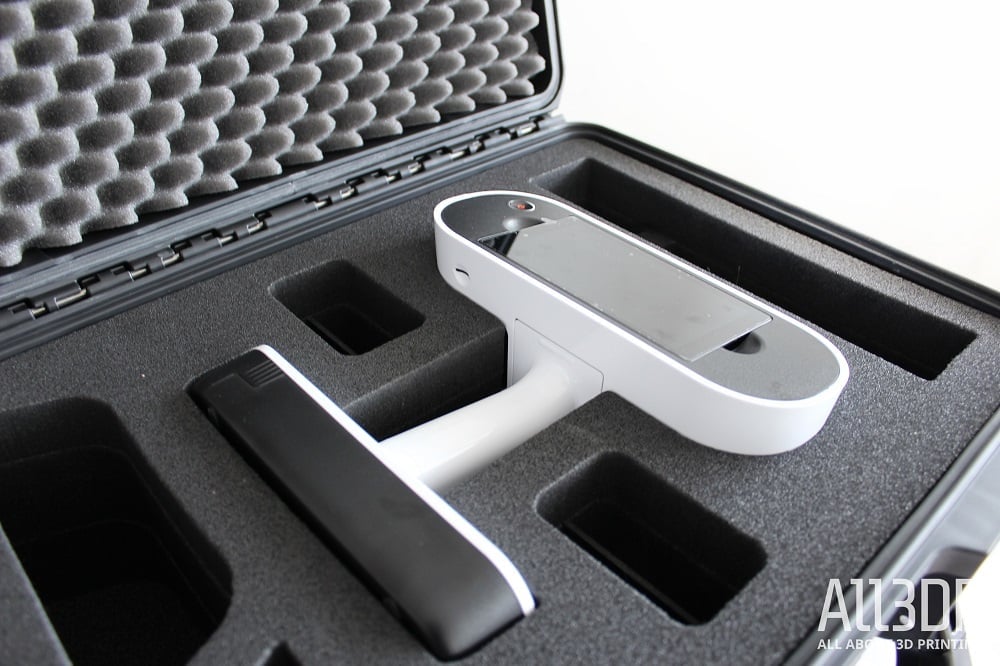
Artec did this by equipping it with a powerful embedded processor and battery. This eliminates the need for a computer or stationary power source, allowing users to freely capture objects. And, with batteries that can be easily swapped out as they run out of juice every six hours or so, you’re completely unencumbered and untethered to your laptop or a power outlet.
The company simplified the process by integrating onboard automatic processing and a touchscreen, allowing users to see the 3D replica form in real-time.
It also gives you lots of options to tweak the scans’ settings – for example, to show the frames per second, show frame and texture counters, or adjust the base removal distance – as well as connect to WiFi, create a hotspot, or even send a report to Artec Support. And before beginning a new scan, you can also adjust settings like the texture brightness, the range and select whether you need the texture to be picked up.
In short – it’s easy to use, straightforward, very responsive, and quick – everything a touchscreen should be.
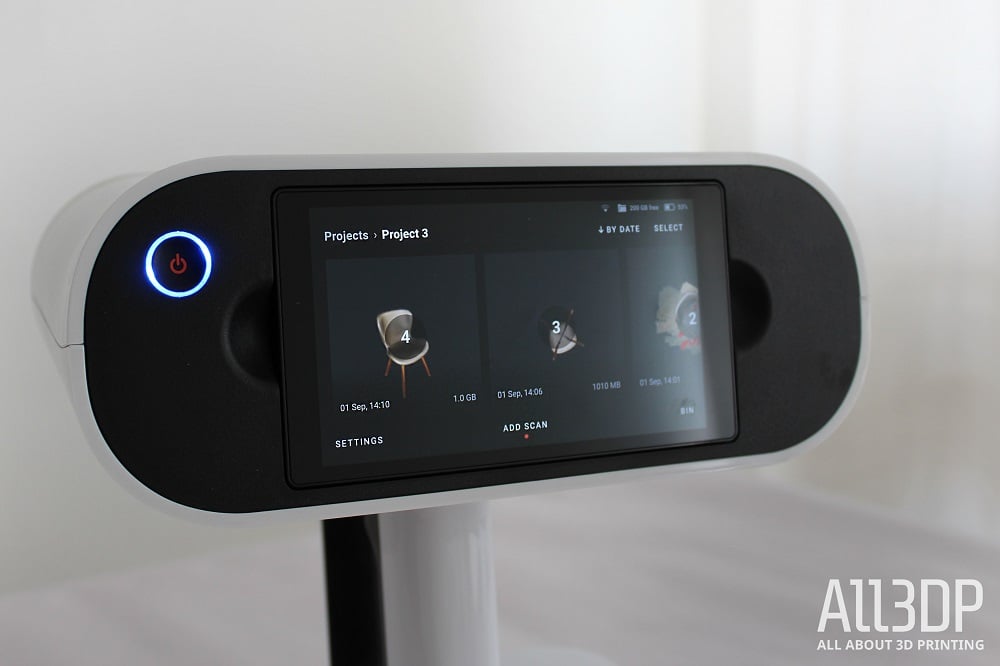
To make the process easier, you can also scan with a distance or quality overlay. The former color codes the scanner’s distance from the object to keep you on track, and the latter color codes areas that need more coverage (yellow or red) and areas with sufficient frames (green). This is useful if you’re not used to scanning yet, but it collects a lot more data than the distance option.
What’s especially useful is that after you’ve scanned an object, you can go back and look at the quality of the data on your touchscreen, rotate the model to make sure all the sections are properly scanned, and, if necessary, go back and rescan certain parts before going through the trouble of uploading the data to your computer.
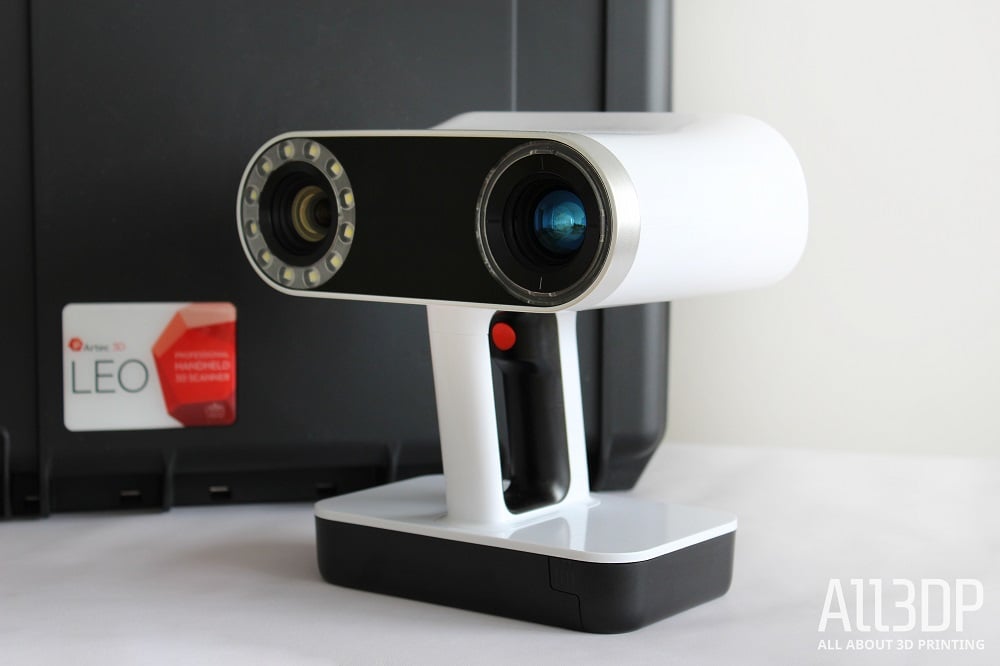
But, of course, the wireless design does have some downsides. Unsurprisingly, having everything you need in a handheld device makes the Leo the heaviest scanner we’ve tested, tipping the scales at 2.6 kg. It’s not a dealbreaker, but it does take some getting used to – don’t be surprised if your hand shakes after using it.
The design also beefs up the scanner’s volume, giving it a kind of cube-shaped footprint, which can be tricky to angle into tight nooks and crannies.
But, these concerns aside, there’s a lot to like about using the Leo.
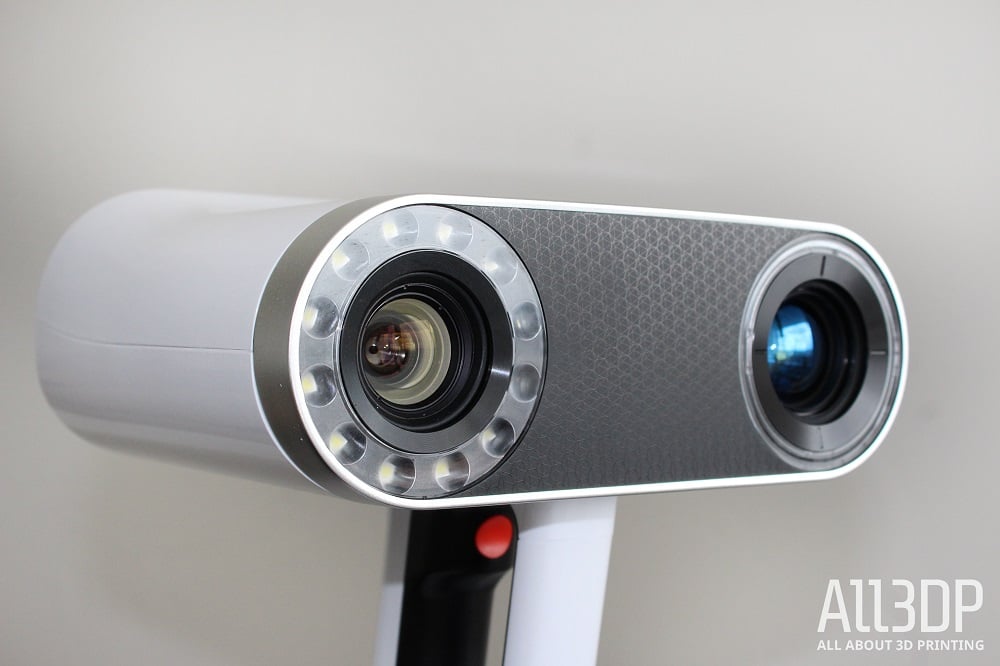
There’s a lot of high-grade technology packed into this 3D scanner, including Nvidia’s “supercomputer on a module” Jetson TX1 processor. Artec leverages this with a 9-degrees-of-freedom (9 DoF) inertial system that consists of an accelerometer, gyro, and compass, allowing the scanner to grasp its position and the surrounding environment.
Despite this hefty-sounding hardware, the Leo doesn’t sound like a jet taking off when it’s running – it’s super quiet.
A particularly appealing aspect to professionals is the scanning speed. The Leo offers a 3D reconstruction rate of 80 frames per second and is equally capable of capturing both large and small objects with intricate details. Using the video camera analogy once again, the company compares this seamless functionality to zooming in on an object.
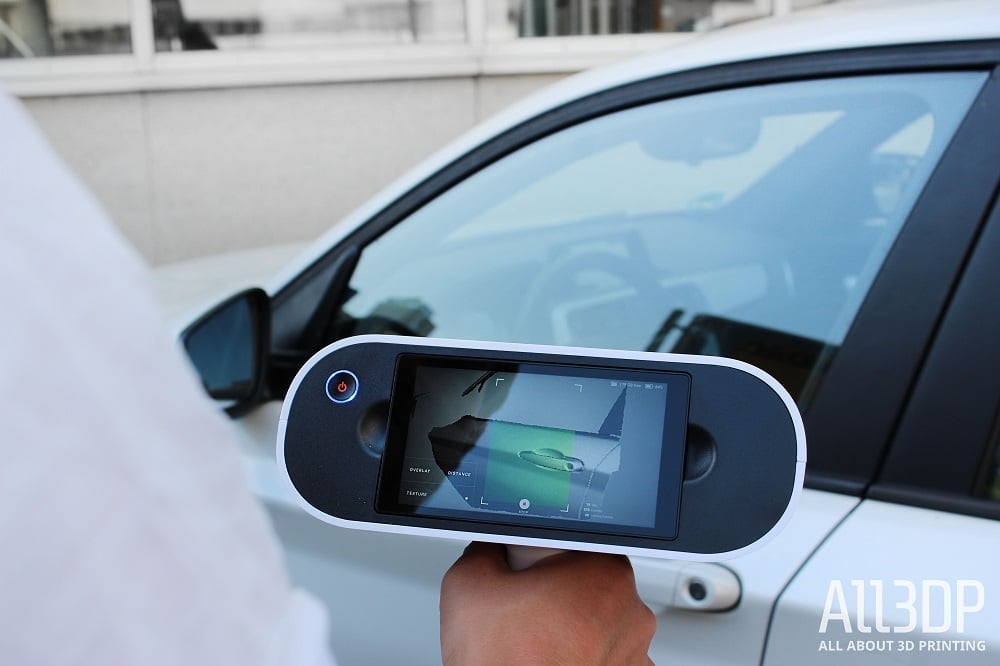
In addition to that, the Artec Leo also has a two-in-one optical system that enhances the ability to capture exact texture to geometry mapping. Developed in-house by Artec, this optical system features a combined 3D camera and texture camera directed through the same lens. This means that you don’t run into snags when applying texture to a scan done by a Leo.
Unlike the Eva, the Leo uses a class 1 laser projector rather than a xenon light projector. This makes the pattern that the Leo projects onto objects invisible so you can scan objects even in sunlight. We found this to be a welcome improvement since it takes holding an umbrella as shade out of the equation. The Leo also comes with a sensor that automatically disables the laser projector if the object is closer than 10 cm away.
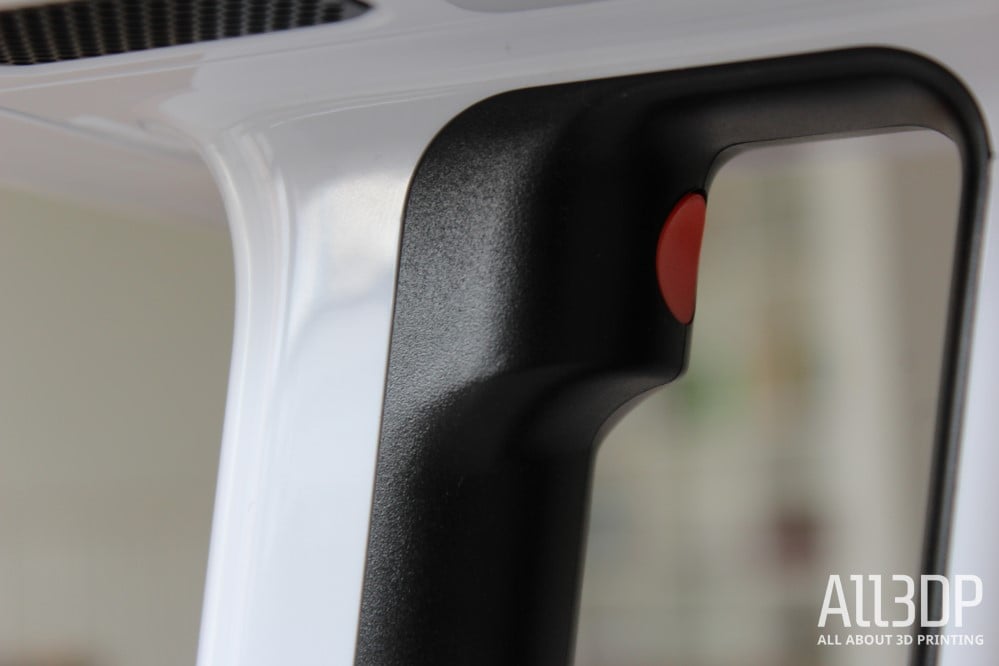
Unlike most other 3D scanning systems, the Artec Leo also has an SSD drive with 256 GB of internal storage. Users can also add SD cards to extend the capacity of this storage space. There’s also a modular side to this feature-packed 3D scanner. It can be mounted to a robotic arm or conveyor system to enable automated 3D scanning and can be synced with other devices for multi-scanning installations.
We found this amount of storage to be more than sufficient – it easily swallowed up large scans, and the processing time was zippy quick.
LEO VS EVA
While the Eva retains its appeal because of its price and its use of Artec’s Studio software, the Leo boasts a combination of cutting-edge hardware and impressive software (for approximately $16,100 more).
Though the machines are alike in most ways, they’re not identical. The Leo has a broader working distance of 0.35 to 1.2 m in comparison to the Eva’s 0.4 to 1 m. It also has a much more generous volume capture zone of 160,000 cm3 to the Eva’s 61,000 cm3, a larger linear field of view, angular field of view, and texture resolution (2.3 mp to 1.3 mp).
Like the Eva, the Leo will struggle with features like flat and repetitive patterns and textures, as well as objects that are all the same color or have fine geometry. But, since the field of view is much bigger with the Leo than with the Eva, we found it was much better at tracking, evidenced by it getting lost way less frequently on featureless surfaces.
Also, as with the Eva, we found the Leo really struggled with anything transparent, black, or shiny. There are workarounds for this depending on what you’re using the scanner for, such as spraying some scanning spray on the object – but it’s not a perfect fix for everything. However, Artec’s Studio software has come out with version 15.1, which makes scanning these surfaces much easier – read more about it in our software section below.

USES
The freedom of movement that the Artec Leo provides makes it an ideal system for scanning a wide range of objects, from tiny mechanical parts to things as large as cars and boats. This makes the 3D scanner well-suited for a variety of applications, including industrial manufacturing, healthcare, forensics, VR, e-commerce, and more.
According to Artec, the Leo is particularly appealing to non-engineers, especially healthcare workers, because the workflow can be split – a doctor or nurse can handle the scanning and then pass over the data processing to a 3D technician – and because since it scans faster, it’s easier to scan children.
In fact, in general, we found scanning people with the Leo to be one of the most impressive aspects of the machine. Since the scanner is much faster than the Eva, scanning people was a much smoother process because the subjects didn’t have to stay still for as long. Plus, there wasn’t the hassle of avoiding wires and balancing a laptop in hand.
Whether the hefty price tag is worth it for your uses, though, is up to you.
Software: Artec Studio 15.1
Last but not least is the powerful and intuitive software developed with Artec’s proprietary 3D algorithms. The Artec Leo scanning software is already integrated into the device and is accessible via the simple touchscreen interface. Once a scan is captured, the data can be sent to Artec Studio for editing, processing, and analysis.
You can transfer your data from the scanner to Artec Studio via WiFi, Ethernet cable, or direct connection by creating a hotspot with the scanner itself. Unfortunately, the process is not the fastest, so expect to wait a little bit, but once your scans have been transferred, expect the same workflow as with the Eva.
Artec’s software is one of its greatest selling points. It’s truly powerful and gives you the range of capabilities necessary for more advanced functions like reverse engineering. We already reviewed Artec Studio software in our Artec Eva review, but since then, Artec has come out with a new version – Artec Studio 15.1, which introduces HD mode to users.
We haven’t gone hands-on with it, so we can’t comment on how well it works for us, but Artec took us through the software changes, and we’re cautiously impressed.
The main draw of HD mode is it makes it easier to scan tricky surfaces that tend to flummox the Leo and Eva.
To use this mode, you just turn the scanner on, activate HD mode, and then when you import the data, you can choose whether you’d like to import the HD or SD scans – the rest of the workflow stays the same.
It’s an extremely resource-intensive mode, so you’ll potentially need to upgrade your hardware if you don’t already have an advanced GPU – the company says you’ll need an Nvidia GPU with at least 4 GB of video RAM if you’re using a Leo. Artec says this problem should be ironed out by the Artec Studio 16 release, whenever that will be.
As you can see in the above scan made by Artec, the sharp edges, grooves, and holes are well handled in HD mode (Source: Artec 3D)
Resource-intensive issues aside, the HD mode looks promising, expanding what Artec Leo and Eva can scan to include surfaces that are black, shiny, transparent, or have very sharp edges. Perhaps most impressive, though, is that though the Leo’s maximum resolution 0.5 mm, with HD mode activated, you can get resolutions of 0.3 mm or 0.2 mm depending on the size of the object.
Another feature is the way it sorts out the noise. It automatically filters out the noise so the scans look more like the real thing – tricky items with lots of holes in them, which would normally fuse together, become much clearer in HD mode with no additional work.

The company was able to do this by using a proprietary AI engine. Previously, when you scanned with an Eva or Leo, some of the data captured was disregarded by the algorithm because it couldn’t be connected with the rest of the data. For example, the bottom of a hole may not have enough data, and so the algorithm would disregard all of the data for it. But, what the AI engine does is it manages to connect all the data, and because of this, it doesn’t need to throw any of it away.
Essentially, all the hardware is the same, just the software has a new algorithm which preserves 100% of all the data captured, giving a better result. This means it can pick up surfaces that previously tripped it up.
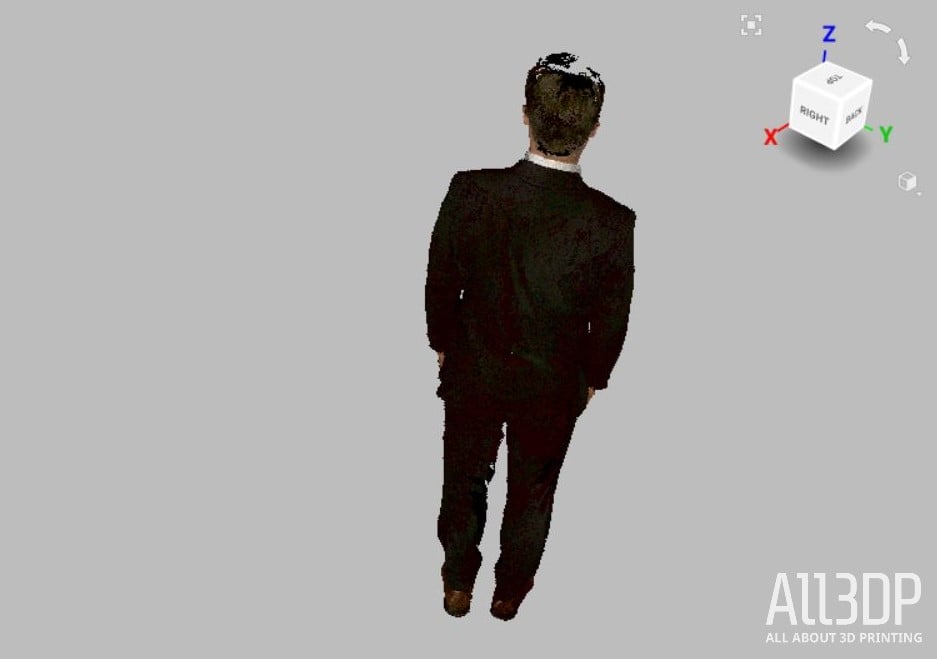
Is It Worth It?
The Artec Leo is an impressive machine that’s completely unencumbered by its predecessor’s cables and wires. Boasting a touchscreen and an intuitive user interface, the 3D scanner is easy to use and can run for up to six hours on one battery. Though the Leo is larger than many, if not most handheld scanners – which gets in the way when scanning tight spaces – and is quite heavy due to all the extra hardware, this is a machine that takes 3D scanning to new levels.
Combined with Artec’s software, which helps you get the most out of your scans and regularly receives updates that expand its capabilities, the Leo is a great machine for any user – provided they have the budget for it. It’s ideal for those with extra money to spend, who like to have the latest technology, and above all, want to scan wirelessly.
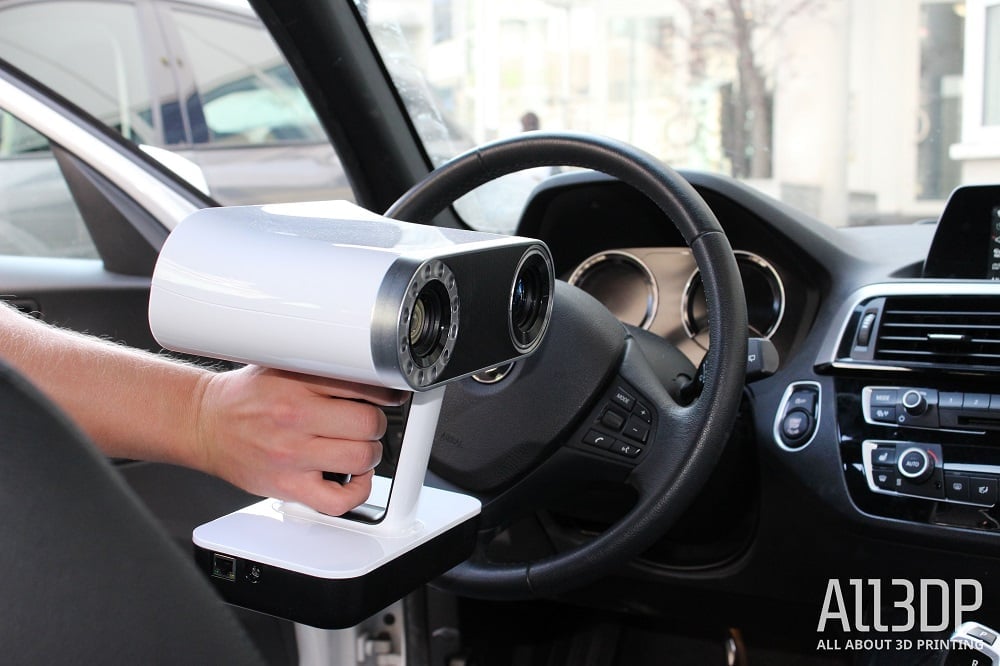
Tech Specs
Here are the technical specifications for the Artec Leo 3D scanner:
General Specifications
- Display: Built-in half HD touch panel screen
- Processing: On-board real-time processing
- Working distance: 0.35 – 1.2 m
- Volume capture zone: 160,000 cm³
- Linear field of view, HxW at closest range: 244 x 142 mm
- Linear field of view, HxW at furthest range: 838 × 488 mm
- Angular field of view, HхW: 38.5 × 23°
- 3D reconstruction rate: up to 80 FPS
- 3D resolution: up to 0.5 mm with standard mode, up to 0.2 mm with HD mode
- 3D point accuracy: up to 0.1 mm
- Texture resolution: 2.3 mp
- Colors: 24 bpp
- Structured light source: VCSEL
- Data acquisition speed, up to: 3 million points/second
- Position sensors: Built-in 9 DoF inertial system
- Connectivity: Wireless connectivity and data transfer
- Display: Integrated 5.5″ touchscreen
- Power source: In-built exchangeable battery, optional mains power
- Multi-core processing: Nvidia Jetson TX1
- Internal hard drive: 256 GB SSD
- Power Source: In-built exchangeable battery, optional mains power
- Interface: WiFi, Ethernet, SD card
Weight & Dimensions
- Weight: 2.6 kg (5.7 lb)
- Dimensions: 231 × 162 × 230 mm
Output Format
- 3D mesh format: OBJ, PLY, WRL, STL, AOP, ASCII, Disney PTEX, E57, XYZRGB
- 3D point cloud format: BTX, PTX
- Formats for measurements: CSV, DXF, XML
Alternate Scanners
You may also be interested in the following 3D scanners:
Creaform Go!Scan Spark
The Creaform Go!Scan Spark is designed for all kinds of tasks, from reverse engineering, prototyping, and VR to quality control, maintenance, digital archiving, and inspection. At just shy of 35,000€ (~ $37,960 USD), the Spark isn’t cheap, but if you’re looking for a scanner that you can rely on for professional and industrial use, it’s certainly worth considering.
Artec Eva
The Artec Eva is very similar to the Leo in terms of specs, even though it came out back in 2012. Despite its age, the Eva has stood the test of time, thanks mostly to the powerful Artec Studio software, which is constantly improving to give you full control over your data. However, keep in mind that due to its age, the Eva is a little clunky.
Artec Eva Lite
If you don’t need texture scanning capabilities, get the Eva Lite, which costs €7,000 (~$7,630 USD) less. At $9,800, it’s significantly cheaper, but with the same high-quality geometry capturing abilities. Plus, if you ever change your mind and decide you do want texture scanning, it’s an easy fix – pay the difference between the Eva and Eva Lite, and Artec will unblock the texture scanning capabilities.
Peel3D Peel 2
The Peel 2 may offer everything you need at a lower price point than the Eva. This scanner is essentially Creaform’s old Go!Scan 50 and, priced at $7,490, it aims to hit that sweet spot of professional users along with hobbyists and creatives.
License: The text of "Artec Leo 3D Scanner Review: King of the Jungle" by All3DP Pro is licensed under a Creative Commons Attribution 4.0 International License.
CERTAIN CONTENT THAT APPEARS ON THIS SITE COMES FROM AMAZON. THIS CONTENT IS PROVIDED ‘AS IS’ AND IS SUBJECT TO CHANGE OR REMOVAL AT ANY TIME.

